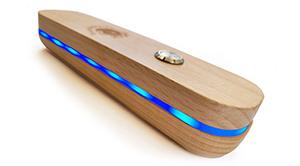A Predictable and Honorable Product Launch Failure
Our recent launch of Dream Changer on Indiegogo has failed. It didn’t just merely fail, it really most sincerely failed. Dream Changer is a placebo remote control that helps kids overcome nightmares. It’s a nice looking product with a wonderful back story and was shown to work in a formal field study.

In the event, we raised a total of $97 (note the lack of zeros) on day 1 of the campaign and not a dollar more was pledged in the two weeks that followed. That’s despite sending out a formal press release via PR Newswire, reaching out directly to 50+ media and influencers who care about kids and sleep issues, setting up a Facebook group a year in advance with regular posts by a world renowned pediatric sleep expert, a formal study showing it works that was published by Oxford University Press and a great looking product at a reasonable price (ok it was a hit high).
Let’s be clear. I LOVE this product idea. Even though it failed.
When it was submitted to Invention City in October 2017 we performed a Brutally Honest Review and the answer should clearly have been “no.” Meaningful patent protection was unavailable, so it would be easy to knock off. The market was small and unproven. No formal studies had been run to show that it worked. A prototype hadn’t been built. A trademark hadn’t been filed. Our Inventicator evaluation scored it as a “long shot.” The product didn’t even do anything. It was a placebo!!
But the name got me. “Dream Changer.” How cool is that? Studies have shown that placebos work. I figured that even though the market was small, it could be easily targeted and that a large enough portion of the target market would buy the product. And when I met the inventors and heard their story about how the invention changed their daughter’s life, I was hooked and ignored my own advice. We licensed the invention and subsequently filed for a design patent and a trademark, hired industrial designers, invested in a website, produced a video, worked on sourcing...
Did we run a survey to test our assumptions? We did not. But when a formal study found that Dream Changer™ really helped kids with nightmares, we felt optimistic. We also thought that getting the attention of press and influencers would be pretty easy. Since we were impressed with the story about the product ourselves, of course media and influencers would be impressed too.
Our assumptions were wrong and the project failed. That’s the sad news.
After the fact, as a post mortem, I ran the survey that we could have, should have, run 4 years ago. The key question in our product surveys is the “will you buy” question. At a bare minimum, we like to see a combined total of 50+% of respondents in the target market saying they would buy the product today or would likely buy the product in the next week or two. The question measures hotness, not likely sales. For Dream Changer™ the “will you buy” question resulted in just 32% saying they would buy it.
We also solicited comments in the survey. Of those who responded, the comments broke down to 20 negative, 28 indifferent or unsure and 29 moderately to strongly positive.
Some of the negative comments were surprisingly hostile, much more negative than I've seen with other products:
“I think it's a joke, ridiculous!”
“it seems hokey”
“Waste of money”
“Scam”
“I am not saying it doesn’t work, but it is a gimmick and will make kids dependent on one more thing.”
Here are examples of of the strongest positive comments:
“It is life changing.”
“Great design. Great idea.”
“It's incredibly interesting. It may be able to help with PTSD”
One thing I’ve learned over the years is that you can’t argue with consumers. All you can do is try to hone your message so that they respond more positively. That’s another problem Dream Changer™ faced. It’s a low cost product with a small market and that meant that there wasn’t a budget for advertising; without media and influencer support, there was no way to even try to convince people to give it a chance.
After reading this, you may think, “Well, that product was obviously going to fail. I would never invest in something like that.” Maybe so. Would you have said the same thing about a technologically brilliant invention by one of the world’s greatest inventors, an invention that smart money in Silicon Valley swooned over, that futurists predicted would actually cause cities to be redesigned to accommodate it? I’m talking about the Segway, a meaningful failure, which also scores “long shot” on the Inventicator. On the other hand, the original Pet Rock scores high on the Inventicator and it was both a useless product and an undeniable success. (you can check out your own invention on the Inventicator app here - we find that most inventors self-score themselves about 50 points too high).
The positive news here is that the failure of Dream Changer supports our invention evaluation methods. Next time my head is turned by a cute idea with a cute name, I’ll take our own advice.
I’m proud of the work we did, thankful to the inventors for giving us the opportunity, thankful to the designers and prototypers who helped us and especially thankful to Professor Michael Gradisar who organized the research that gave the product a real chance. Maybe in the future, fingers crossed, someone will decide the project is worthy of resurrection and fund it for use in hospitals and rehab facilities. We'll be happy to step up again if that ever happens.#
share this article: facebook